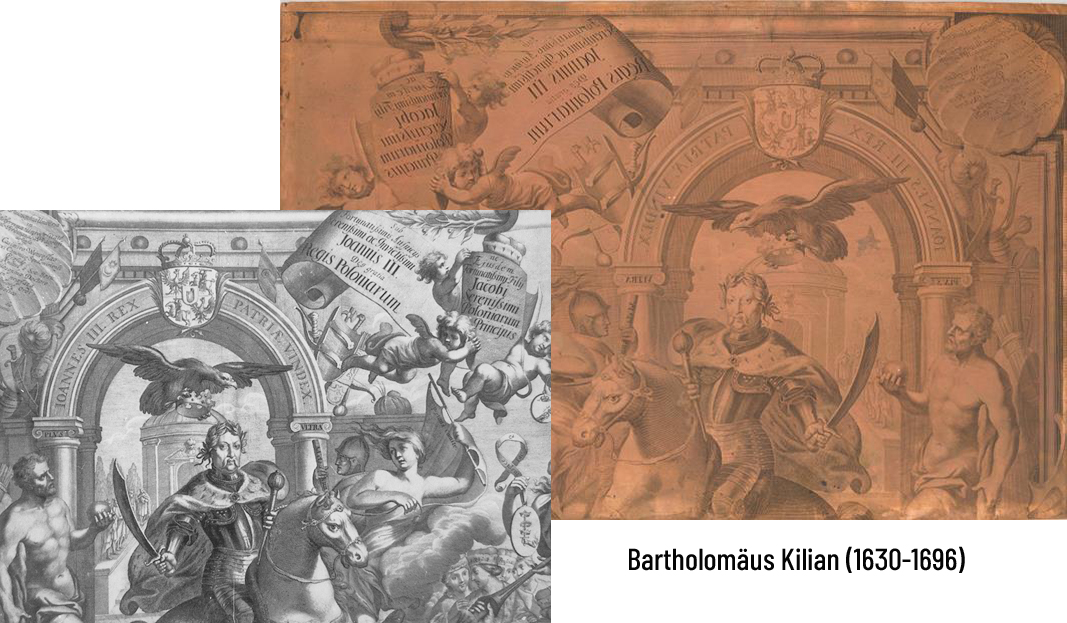Bartholomäus II Kilian

Bartholomäus II Kilian was born in the middle of the Thirty Years' War. He had just turned eighteen when the war ended and as a young craftsman was thus able to benefit from the recovering economy. He took his name from his grandfather Bartholomäus I Kilian, a goldsmith from Silesia who had immigrated to Augsburg. Bartholomäus I died at an early age, leaving a widow and two small children, Lucas and Wolfgang, behind. Kilian's widow married Dominicus Custos, who came from a widely branching Antwerp artists’ family and taught Lucas and Wolfgang Kilian the craft of engraving. In terms of both artistry and business affairs, Custos thus became the progenitor of the Kilian-Custos dynasty, which continued to produce highly talented artists until the end of the eighteenth century.
Lucas and Wolfgang learned drawing, engraving, etching and publishing in their stepfather's workshop and publishing house. The range of subjects was quite broad, but even at this early point in time the focus was already on portrait engravings.
Wolfgang Kilian’s contemporaries considered him the artistically weaker and less expressive of the two brothers, but his enormous versatility and extremely long creative period, which lasted well past his eightieth birthday, are impressive. In addition to the portraits already mentioned, he worked on book illustration, large theses for Southern German, Bohemian and Austrian universities and the frontispieces for related dissertations. He passed his knowledge, skills and contacts on to his sons Bartholomäus II and Philipp.
Bartholomäus worked with his father on book illustrations from a young age, gradually specializing in portraits. He continued his training in this discipline in Paris, where he sojourned for several years around 1650, possibly with the Augsburg-based engraver Elias Küsel. In Paris he studied the art of Robert Nanteuil, Grégoire Huret, François de Poilly, Henri Testelin, François Chauveau, Balthasar Moncornet and many others.
Enriched by these impressions, Bartholomäus returned to Augsburg, where, like his uncle Lucas decades before him, he came to be known as the best German portrait engraver of his time. His talent and skill for detailed craftmanship and artistic expressiveness paved his way into the lucrative market of large-scale portraits for funeral sermons.
At the same time, he became known for his sometimes extremely large theses of up to 2 x 2.5 metres in size (shown here: details of the copper plate and print of a thesis dedicated to Johann III Sobieski, King of Poland). He frequently worked from designs by such artists as Jonas Umbach, Burkhard Schramman, Johann Christoph Storer and Karel Škréta.
Until Wolfgang Kilian’s death, Bartholomäus continued collaborating with his father on book illustrations, for example for the internationally highly successful large-scale project Atlas Marianus by Wilhem Gumppenberg. Some years later he contributed to Aegidius Ranbeck’s Calendarium Annale Benedictinum, an extremely large project with a portrait of a Benedictine saint for every day of the year. The project was overseen by Johann Georg Waldreich, who had gained a reputation for himself in this function.
In addition to his work as an engraver and publisher, Bartholomäus Kilian was very active as a teacher. As his fellow artist Johann Ulrich Kraus reported, he taught numerous students in his workshop, the most known and talented of whom was certainly Leonhard Heckenauer. Although he did not reach his father Wolfgang’s advanced age, he remained active as an engraver until shortly before his death. Bartholomäus II Kilian died in 1696 at the age of 65.
Compiler: Jörg Diefenbacher
Editor: Eckhard Leuschner

